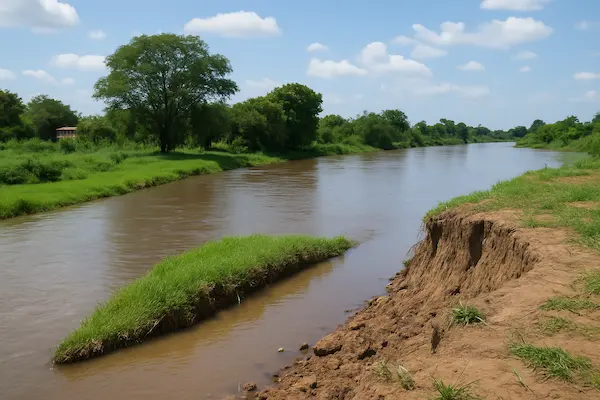WHAT IS ACCESSION AND HOW DOES IT APPLY TO REAL ESTATE?

CONSTRUCTION ON OWN LAND WITH THIRD-PARTY MATERIALS
If a landowner builds on their property using materials that belong to another person, the landowner becomes the owner of those materials. However, they must compensate the material owner. If the builder acted in bad faith, they must also pay for any damages. The material owner may request the removal of their materials, provided this does not cause serious harm to the structure or result in the loss of the plantings, and only within six months of discovering the use.
THIRD-PARTY CONSTRUCTION ON OWN LAND
When someone else builds on a property using their own materials, the landowner has the option to retain the construction or demand its removal. If they choose to retain it, they must pay either the value of the materials and labor or the added value to the property. If they opt for removal, the costs fall on the builder. However, the landowner may not demand removal if they knew of the work and did not object, or if the builder acted in good faith. The right to request removal expires six months after the landowner becomes aware of the construction.
USE OF THIRD-PARTY MATERIALS BY A THIRD BUILDER
If a third party builds using materials owned by someone else, the material owner may request removal, as long as it doesn’t damage the structure or the land. If removal is not possible—or if more than six months have passed since they learned of the incorporation—they may demand payment for the materials. If both the builder and landowner acted in bad faith, they are jointly liable for the value and any damages.
NATURAL ALTERATIONS TO LAND AND PROPERTY OWNERSHIP
GRADUAL INCREASE THROUGH ALLUVION
When a river or stream gradually and consistently deposits soil onto adjacent land, that increase becomes the property of the landowner benefiting from the addition. This type of natural expansion cannot be contested by the landowner on the opposite bank.
SUDDEN DETACHMENT THROUGH AVULSION
If a river current suddenly detaches an identifiable portion of land and attaches it to another property, the new landowner gains rights over it. However, the original owner may demand compensation for the added value to the neighboring land, provided the claim is made within one year of the event.
SPECIAL CASES INVOLVING WATERCOURSE CHANGES
Disputes arising from river course changes, island formation, or other natural alterations are governed by specific regulations, due to their technical and environmental complexity.
ACCESSION IN MOVABLE PROPERTY: COMBINATION, MIXTURE, AND SPECIFICATION
Although the focus here is on real estate, Bolivian law also regulates accession concerning movable property.
COMBINATION OR MIXTURE OF MOVABLE GOODS
When movable goods from different owners are combined and cannot be separated, ownership becomes joint based on the value each item contributes. If one good is clearly principal, its owner may claim the whole, paying the corresponding value to the others. If the mixture occurred without consent, the primary owner is required to pay only the lesser amount between the accessory good’s value and the greater value of their own, plus any potential damages.
SPECIFICATION OF A NEW ITEM USING THIRD-PARTY MATERIAL
If someone manufactures a new item using another person’s raw materials, they may acquire ownership by paying for the materials. However, if the cost of the materials exceeds the value of the labor, the original material owner can reclaim the finished product by compensating for the workmanship.
CONCLUSION
Accession in the context of Bolivian civil law is a legal tool that addresses common scenarios involving the incorporation of third-party property, whether by natural processes or human action. These rules aim to balance the interests of landowners, material owners, and builders, promoting legal certainty in property relations and supporting orderly urban and rural development.
Dealing with a dispute over construction or land changes? Contact us for expert legal advice on property and accession matters.
Frequently Asked Questions (FAQs)
What happens if I build on my land using borrowed materials and fail to return them?
You become the owner of the materials but must pay their value. If you acted in bad faith, you must also compensate for any damages.
Can I keep a construction made on my land by someone else without my permission?
Yes, you can retain the construction, but you must pay either the value of the materials and labor or the added value to your land.
What is the deadline to request the removal of materials or constructions?
Generally, six months from the date the property or material owner became aware of their use or incorporation.
What happens if a river changes its course and affects my property?
Depending on the case, you may gain land or be required to compensate the former owner. Special laws govern such situations.
Can I lose part of my land if the river drags soil onto another property?
Yes, but you can request compensation within one year of the event, if the change was sudden and identifiable (avulsion).
The content of this article does not reflect the technical opinion of Rigoberto Paredes & Associates and should not be considered a substitute for legal advice. The information presented herein corresponds to the date of publication and may be outdated at the time of reading. Rigoberto Paredes & Associates assumes no responsibility for keeping the information in this article up to date, as legal regulations may change over time.


